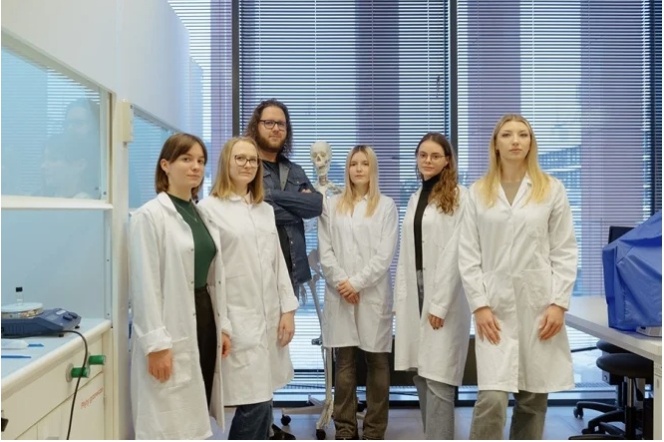Date added: 2024-02-14
New functional bone cements to substitute defects and accelerate regeneration

Bone cements for clinical applications, i.e. self-hardening bone substitutes, are usually biomaterials consisting of powder and liquid. When mixed, they form a paste which when applied to the body hardens in a chemical reaction. Recently, there are various forms of bone regeneration materials, including polymer cements (mainly composed of polymethyl methacrylate) and ceramic cements (usually composed of calcium phosphates). The first group of materials is not bioactive, so they do not create a stable connection with the bone tissue and do not support regeneration. The latter are mechanically weak and difficult to apply. Early-career researchers form Gdańsk University of Technology are working on alternative materials without these limitations.
– We can already offer new solutions for biocomposite bone cements we have developed on the basis of magnesium phosphate and enriched with various hydrogels. What distinguishes our cements are their improved functional properties and reduced brittleness, which enhance their bone reconstruction potential. When applied in minimally invasive surgical procedures, they should meet the demands of modern medicine, says the research manager Marcin Wekwejt, PhD, from the Department of Biomaterials Technology at the Faculty of Mechanical Engineering and Ship Technology at Gdańsk Tech.
Current research focuses on further optimization of the biofunctionality of the obtained bone cements. The goal of the research team is to obtain more a biomimetic material with increased mechanical strength (potentially also pseudoplastic), as well as one that has physico-chemical properties tailored to specific medical applications.
We have taken up the challenge of developing a dual-setting cement obtained as a result of two "controllable" and simultaneous hardening reactions: ceramic (hydration) and polymer (cross-linking), so that the hardening time can be additionally adjusted to a given surgical procedure, making the application easier and safer – says Marcin Wekwejt. – We strive to develop cements that are fully biodegradable after implantation and demonstrate the most favorable biological properties. In consequence, through the release of bioactive ions, the composite supports bone cell proliferation and promotes the creation of a stable bond with the human body, contributing to effective bone regeneration.
The proposed cements are to be widely used in medicine - for various types of fractures, osteoporosis, diseases such as peri-implantitis (an inflammatory reaction affecting the tissues surrounding the implant), or for bone defects reconstruction after tumor resection.
Student contribution to the research
Research on ceramic bone cement, the main component of future biomaterials, started with the project named "Development of a novel bone cement based on magnesium phosphate dedicated as a degradable bone substitute”, conducted as part of the Technetium program by a research team including students, led by Marcin Wekwejt. Researchers analyzed different technological parameters and their impact on the final properties of this material. Their research resulted in an original technology for the production of ceramic cement, submitted for patent protection.
The team continued their research in another project titled “Development of a novel injectable ceramic-polymer bone cement” within the Plutonium program, modifying the cement by adding different types of polymers, mostly of natural origin, to improve the performance properties of the material.
– We have already started the patenting process for three proposed bone cement technologies and published the results of first research findings. The paper was a result of cooperation established with the Department of Functional Materials in Medicine and Dentistry of the University of Würzburg and concerns poly(HEMA) addition in magnesium phosphate cements. The project is in progress and each stage brings more and more promising results. Therefore, we are already preparing next patent applications and scientific publications – says Marcin Wekwejt.
Research teams
Moreover, the Plutonium project is conducted as part of inter-university cooperation: with Justyna Kozłowska, associate professor at Nicolaus Copernicus University in Toruń, who is responsible for chemical aspects, Anna Ronowska, PhD from the Medical University of Gdańsk, responsible for biological aspects, and Prof. Uwe Gbureck, specialist in ceramic cements from the University of Würzburg, as well as inter-faculty cooperation of Gdańsk University of Technology with Aleksandra Mielewczyk-Gryń, associate professor at Gdańsk Tech, from the Ceramics Department at the Faculty of Applied Physics and Mathematics.
Awards
The team members are already successful. Rafał Jesiołkiewicz took second place in the best scientific poster competition at Nano(&)Biomateriały 2023 conference, while one of the research concepts developed under the Plutonium program, i.e. "bone cement based on magnesium phosphate modified with alginate hydrogel" was awarded in the national StRuNa-SCIENCE2023 competition and won first place in the scientific project category as part of Złote Lwiątka 2023 (Gdańsk Tech award).
AI-generated image on home page.

